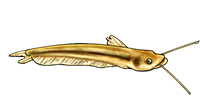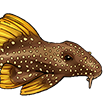Cohen, M. S., Hawkins, M. B., Knox-Hayes, J., Vinton, A. C., & Cruz, A. (2018). A laboratory study of host use by the cuckoo catfish Synodontis multipunctatus. Environmental Biology of Fishes, 1-9.
Https://link.springer.com/article/10.10 ... 018-0788-1
Abstract
The only known non-avian vertebrate obligate brood parasite is the cuckoo catfish (), a Lake Tanganyikan endemic. The cuckoo catfish parasitizes Tanganyikan mouthbrooding cichlids, and under captive conditions, will also parasitize cichlids from other Rift Valley lakes. Here we examine the frequency of parasitism by the cuckoo catfish of from Lake Tanganyika and three species from Lake Malawi and the greater Lake Victorian system in a laboratory setting. C. horei was parasitized significantly less (17%) than the allopatric species , , and (combined parasitism rate of 28%). The lower rates of parasitism in C. horei may be due to differences in the mating ritual, oviposition (e.g., long periods of pseudo-spawning before actual oviposition), and behavioral adaptations (e.g., increased aggression towards the cuckoo catfish). The number of catfish eggs per parasitized brood was similar between C. horei, H. latifasciatus, H. nubilus, and M. estherae. Our results are comparable to findings from the field for C. horei parasitism frequency and number of cuckoo catfish per brood. We also analyzed the parasitism rate of the albino morph of , a domestic strain. Parasitism rates and number of catfish per brood were the highest in the albino morphotype suggesting that the higher levels of parasitism may be related to lower aggressive behavior, lower visual acuity, or captive influence. Cuckoo catfish and mouthbrooding cichlids provide a model system for testing brood parasitism in a laboratory setting.
Keywords: Brood parasitism, Cuckoo, Catfish, Synodontis, Tanganyika
Laboratory study of host use by the cuckoo catfish Synodontis multipunctatus
- bekateen
- Posts: 9739
- Joined: 09 Sep 2014, 17:50
- I've donated: $40.00!
- My articles: 4
- My images: 144
- My cats species list: 148 (i:107, k:33)
- My aquaria list: 37 (i:14)
- My BLogs: 46 (i:157, p:2646)
- My Wishlist: 36
- Spotted: 186
- Location 1: USA, California, Stockton
- Location 2: USA, California, Stockton
- Contact:
Laboratory study of host use by the cuckoo catfish Synodontis multipunctatus
Find me on YouTube & Facebook: http://youtube.com/user/Bekateen1; https://www.facebook.com/Bekateen
Buying caves from https://plecocaves.com? Plecocaves sponsor Bekateen's Fishroom. Use coupon code bekateen for 15% off your order. Also, for you Swifties: Https://youtu.be/ZUKdhXL3NCw










